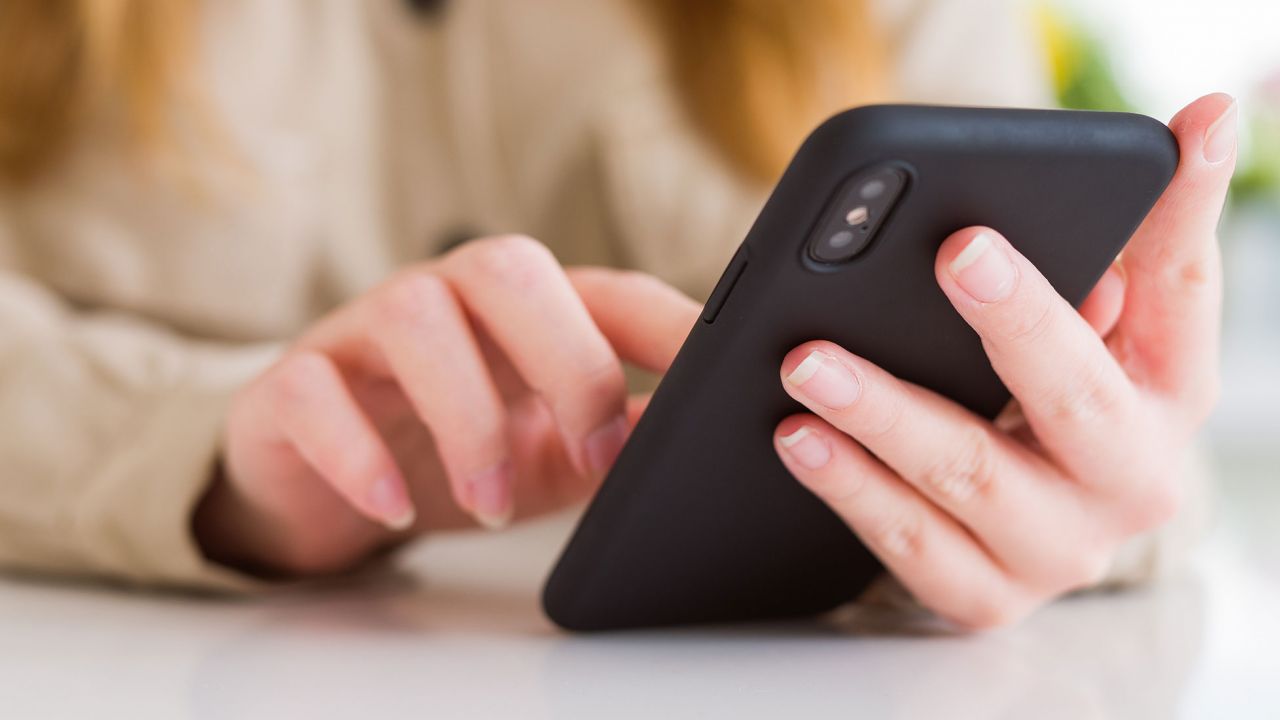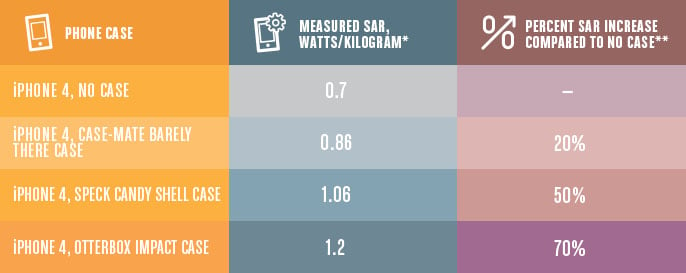
Some 89 percent of Americans use smartphones. Many of them buy cases for their phones, hoping to protect their expensive devices from harm. But it’s the users who need better protection.
A new EWG analysis of data submitted to the Federal Communications Commission by one manufacturer shows that some cases on the market are so poorly engineered that they actually intensify the radiation that strikes a user’s head and body. Cases may also weaken the signal, deplete the phone’s battery sooner and cause dropped calls.
The data are based on studies by Pong Research Corp., an Encinitas, Calif., company that makes cases designed to minimize cell phone radiation exposure.
Pong’s research indicates that badly designed cell phone cases can partially block a phone’s antenna, making the device work harder to transmit signals. Due to gaps in the FCC’s cell phone regulations, a phone worn right next to the body and enclosed by a case that obstructs the antenna could expose the user to more radiation than the FCC’s legal limit.
The Commission has never acted to ensure that cell phones covered by cases meet the exposure limits.
EWG is calling on the FCC to update its testing guidelines to take account of the widespread use of smartphone cases. Such action is critical because mounting scientific studies have raised serious questions about the safety of cell phone radiation exposure over the short and long term. In the absence of meaningful action by the Commission, EWG offers consumers tips on how to reduce their exposure to cell phone radiation.
Cell phone cases can weaken the signal and raise users’ radiation exposure
Since the FCC issued its first standards for cell phones in 1996, cell phone usage has skyrocketed. Today, the U.S. has more cell phones than people. Smartphones outsell basic phones, and form-fitting cases, frequently designed and sold by third-party manufacturers, have become a multi-million dollar business (CNET 2013).
The government, however, does not require phone manufacturers to consider the effect of cases when they conduct compliance tests to meet the FCC’s allowable radiation exposure limits. The significance of this omission was underscored by tests commissioned by case-maker Pong Research and submitted to the FCC in May 2012. Those tests showed that three models of cases made by competing companies and used with an iPhone4 increased the phones’ Specific Absorption Rate, or SAR – the amount of radiation absorbed by the user’s body – by 20-to-70 percent (Table 1).
Table 1: Cell phone cases can significantly increase radiation exposure

*SAR values are from tests conducted by Pong Research Corp on March 29, 2012 and submitted to the FCC on May 31, 2012. Because the SAR values were submitted to the FCC in graph form, EWG estimated numerical SAR values based on the chart available in WT Docket 11-186 (http://apps.fcc.gov/ecfs/document/view?id=7021921006). Pong’s filing to the FCC did not indicate whether SAR measurements were done at the head or in a body-worn configuration. In a personal communication, Pong informed EWG that the SAR measurements were done in a body-worn configuration, with the same distance from the test mannequin used by the phone manufacturer. Tests in the body-worn configuration were done at a 10 millimeter separation distance.
** Percent SAR increase rounded to the nearest decile.
Pong Research told EWG that it selected the three phone cases in Table 1 because they have varying thicknesses and compositions, reflecting the range of products on the market:
-
A thick, rugged case (Otterbox Impact) that physically creates a larger barrier around the antenna than slimmer cases. This case increased SAR the most.
-
A thin case that leaves the phone partially exposed but nevertheless increased cell phone radiation (Case-Mate Barely There).
-
A popular phone case that does not have the thickness of “rugged” cases (Speck Candy Shell).
None of the three cases contain metallic parts, which are known to affect SAR, but all increased the user’s radiation exposure. The effect on radiation exposure would likely vary with each of the hundreds of cases on the market, and each would have to be tested individually to come up with an exact measure. The results in Table 1, however, are believed to reflect the range of radiation increases.
Manufacturers conduct government-required certification tests using a bare phone, set to transmit at maximum power, with no accessories. The recorded maximum SAR is reported to the FCC and listed in the phone’s manual. A phone tested with accessories under the same conditions can produce a higher SAR because the materials surrounding the antenna can affect the amount of radiation that reaches and is absorbed by the user’s body. A case can influence both the overall amount of emitted radiation and how it is directed.
EWG also reviewed data in the FCC filings on tests of battery life during a continuous call, measured on an iPhone 4 without a case and on the same phone with an Incipio Le Deux case. This case was chosen because it contains metallic parts (a stainless steel back plate). The presence of metallic components influences the phone’s radiation properties, as the FCC acknowledges (FCC 2001; FCC 2014). Under the test conditions with constant signal strength, an iPhone 4 without a case had 85 percent of battery capacity after a one-hour call and 70 percent after two hours. When the test was repeated with the Incipio Le Deux case, the phone had only 65 percent of battery capacity after a one-hour call and only 10 percent after two hours (Pong 2012).
In real-world use, battery life depends on many factors, especially the phone’s distance from the cell phone tower. The Pong data suggest that a phone case can obstruct the antenna and make the phone work harder to transmit its signal, causing battery power to wane more quickly.
EWG’s analysis found that a case could decrease a cell phone’s signal strength by as much as 90 percent (Table 2). Both phone cases in Table 2 both contain some metal (aluminum in the Case-Mate case and steel in Incipio Le Deux).
Table 2: Cell phone cases diminish signal strength, measured as Total Radiating Power

* Total Radiating Power values estimated by EWG from tests conducted in spring 2012 and submitted to the FCC by Pong Research Corp, on May 31, 2012. Available in ET Docket No. 13-84 (http://apps.fcc.gov/ecfs/proceeding/view?name=13-84) and WT Docket 11-186 (http://apps.fcc.gov/ecfs/document/view?id=7021921006).
** Percent TRP decrease rounded to the nearest decile.
The data analyzed by EWG clearly show that a cell phone case is not an inert covering. It can materially affect signal quality, potentially leading to more dropped calls; increase radiation exposure, raising the risk of adverse health effects; and shorten battery life, forcing a cell phone user to charge the battery more frequently.
Does the Pong’s “intelligent antenna technology” work?
To minimize radiation distortion by phone cases, Pong Research designed a case with a built-in antenna that directs the emissions away from the user’s head or body and toward the cell tower, to both improve signal quality and lower radiation exposure (German 2011).
Pong’s claims for its case have stood up to the scrutiny of Wired magazine and the Better Business Bureau (Advertising Self-Regulation Council 2012; Ganapati 2009). In tests conducted by Cetecom, a cell phone radiation certification lab, and observed by a reporter from Wired magazine, an iPhone 3G tested without a case had a maximum SAR of 1.18 W/kg when held at the ear. The same phone tested with a Pong case had a maximum SAR of 0.42 W/kg (Ganapati 2009).
EWG met with representatives of Pong Research and fully agrees with its business premise that cell phone cases should decrease, not increase, radiation exposure. Pong hopes to carve out a niche by selling cases that lower the phones’ radiation exposure. We anticipate that as awareness of the potential risks of cell phone radiation grows, Pong and other companies will respond by marketing cell phones and cases that offer users good communication with less radiation.
How to fix the FCC rules
In light of these findings, EWG urges the FCC to account for the widespread use of cases when updating its 1996 cell phone standards. The Commission began this process in 2012 and it is still in the early stages, but it has not indicated that it plans to consider the effects of cases (FCC 2013a; FCC 2013b; FCC 2013c).
The FCC has several options. It could:
-
Require all case manufacturers to test their cases with all compatible phones to ensure that the phones remain in compliance with federal standards.
-
Require case manufacturers to test their products with a subset of compatible phones to ensure that most phones meet the FCC standards.
-
Require manufacturers that make both phones and cases to show that their phones meet FCC standards when used with their cases.
-
Test a representative sample of popular phones in popular cases to determine how much a case typically increases radiation absorption, and decrease its SAR limit by at least this amount in the updated standards.
Some industry representatives question whether the FCC has the authority to regulate cell phone cases, but there are precedents. In previous guidelines, the FCC has recommended that phones be tested with other items produced and/or supplied by the phone manufacturer. These include holsters meant to be used with the device (FCC 2001).
Since 2001, the FCC has allowed manufacturers to test phones at a distance of up to one inch from the body to account for the use of a holster. In a 2012 report, however, the Government Accountability Office, the Congressional watchdog agency, noted that many cell phone owners actually keep and use their phones right next to the body, so these outdated testing policies could result in radiofrequency (RF) radiation exposure greater than the FCC’s legal limit (GAO 2012). The GAO report concluded:
By not formally reassessing its current limit, FCC cannot ensure it is using a limit that reflects the latest research on RF energy exposure. FCC has also not reassessed its testing requirements to ensure that they identify the maximum RF energy exposure a user could experience. Some consumers may use mobile phones against the body, which FCC does not currently test, and could result in RF energy exposure higher than the FCC limit.
The FCC has yet to implement GAO’s recommendations to more closely reflect real-life use. For a narrow subset of smartphones – those sold with lanyards or straps – the FCC advises manufacturers to test phones at a distance of no more than 5 mm from the body (FCC 2014). Yet the FCC has done nothing to ensure more realistic testing of most other smartphones or to account for the widespread use of accessories such as cases, which many different manufacturers produce with both metallic and non-metallic components.
EWG believes that cell phone testing procedures should include cases and other accessories, whether supplied by the phone manufacturer or a third party. Since these cases and accessories have no other use and have the potential to influence the phone’s transmitting and receiving activity and the amount of radiation that a user might encounter, they fall within FCC’s authority.
EWG urges the FCC to include third party-produced cases and accessories in its cell phone testing policies to ensure that they do not compromise cell phone function and do not prevent a cell phone from complying with the Commission’s exposure limits. Manufacturers should publish the radiation data for a given phone when used directly next to the body and when used with the cases most commonly sold for a specific model.
These data are urgently needed in order to ensure that all devices on the market and the accessories sold for them fully comply with the FCC’s radiation limit under the real-world conditions, not just under the scientifically incomplete and outdated testing conditions used by manufacturers when they apply for initial FCC certification.
What cell phone users can do to protect themselves
Until the FCC establishes testing procedures that fully correspond to real-world cell phone use and reviews its radiation standards to ensure that they are fully protective for all users, including young children, EWG advises phone users to adopt these simple measures to minimize radiation exposure: Use a headset, keep the phone away from the body and text rather than talk.
The government’s policies must change. Cell phone users should make their voices heard to prompt the FCC and manufacturers of cell phones and cases to ensure that these accessories never increase and, to the extent possible, decrease, users’ radiation exposure. At minimum, the FCC must take cell phone cases into consideration when it updates its standards to ensure that the use of a case will not expose people to more radiation than its legal SAR limit.
Click here to sign EWG's petition and tell the FCC to strengthen its cell phone safety standards.

